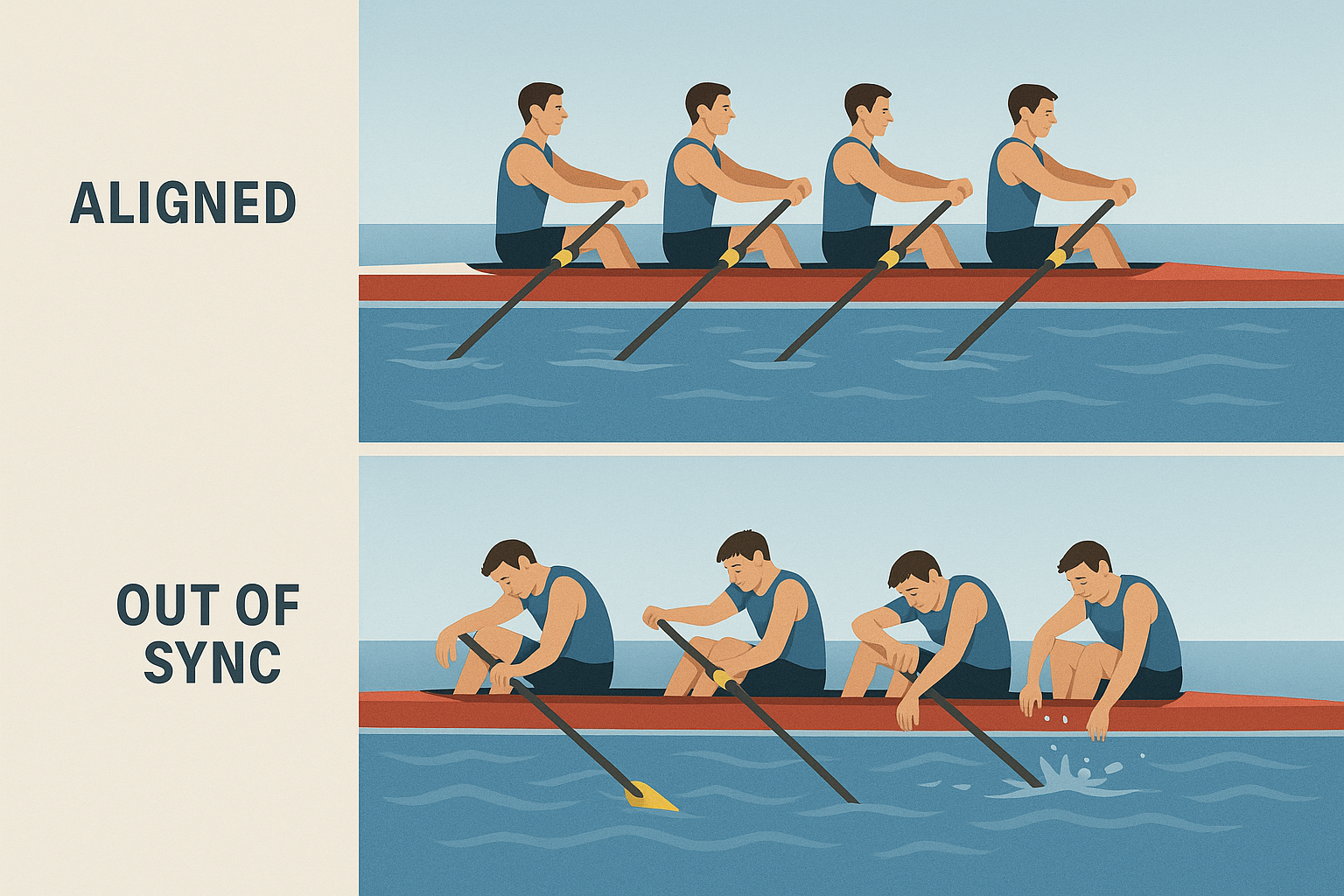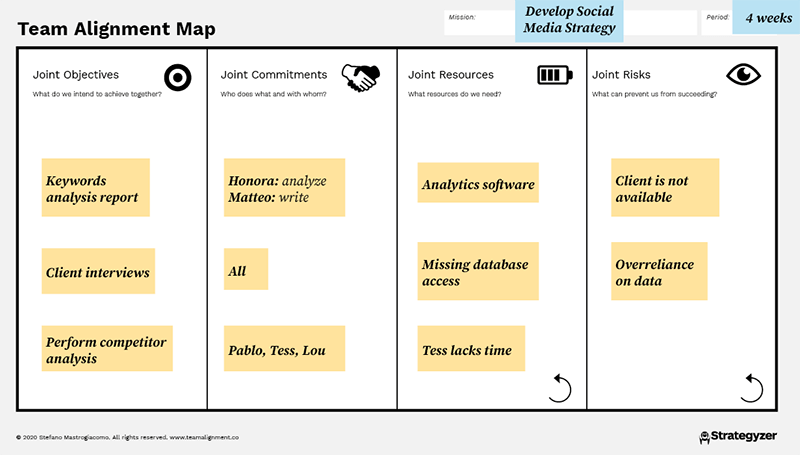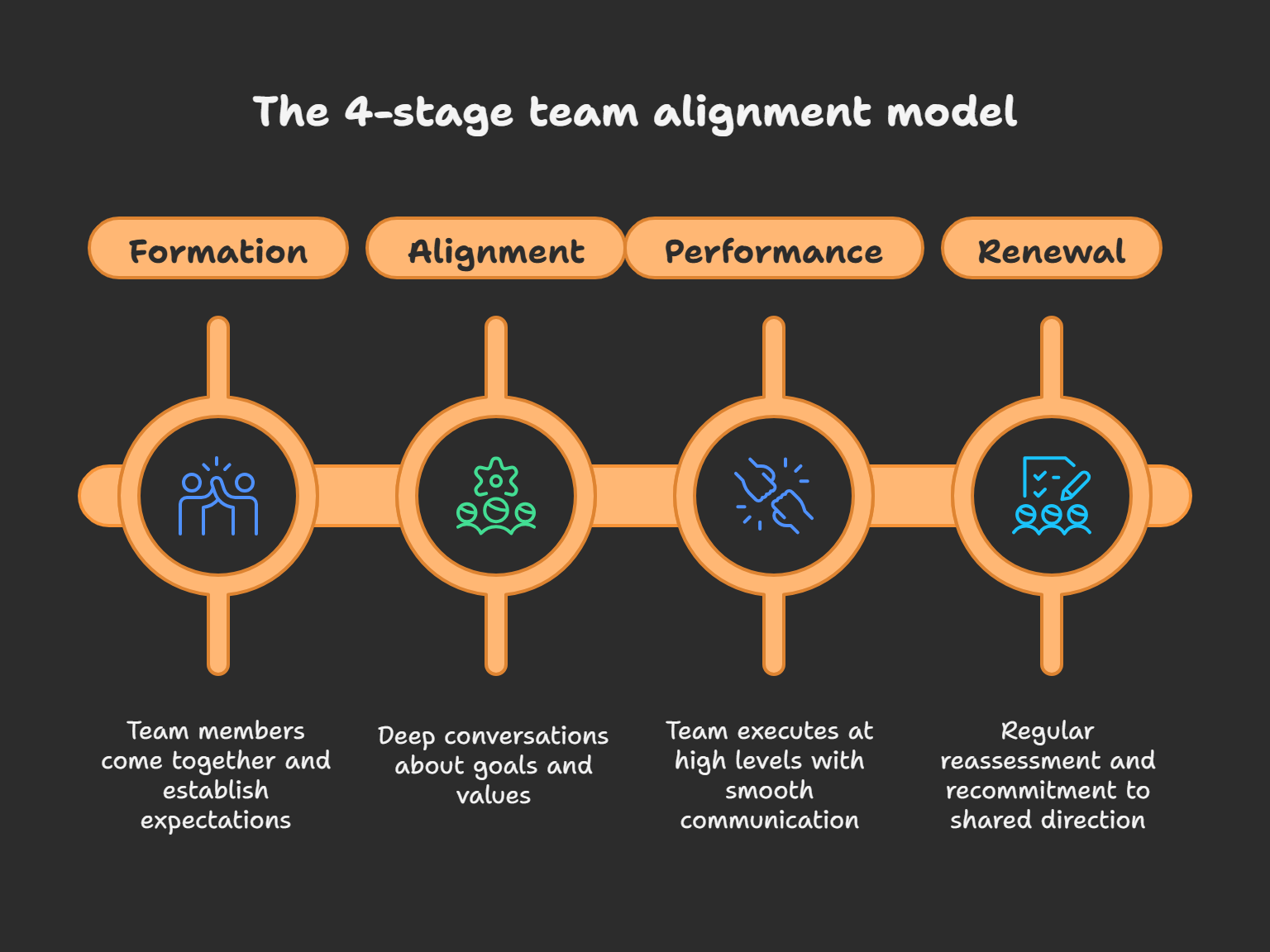The major difference between thriving teams and struggling ones often comes down to one critical factor: team alignment. When everyone is pulling in different directions, even the most talented individuals can't deliver exceptional results.
This post will cover the team alignment framework, its benefits, and tips on how to create a better team alignment. Keep reading to find out more.
What is Team Alignment?
Team alignment is when every team member understands, believes in, and actively works toward the same goals using agreed-upon methods and processes. It's the invisible force that transforms a group of individuals into a cohesive unit that consistently delivers results.
Think of team alignment like a rowing crew. When rowers are aligned, their oars move in perfect synch, moving the boat forward with maximum efficiency. However, when they're out of sync, the boat zigzags through the water, wasting energy and losing speed. This same principle applies to your workplace teams.

True team alignment cuts across four key dimensions:
- Shared vision and goals
- Clear roles and responsibilities
- Consistent processes and workflows
- Open communication channels
When these four elements work together, your teams will experience improved performance, reduced conflicts, and higher job satisfaction.
Benefits of Team Alignment: Why This Matters
Research has shown that aligned teams experience 67% higher employee engagement and are 2.5 times more likely to be high-performing. But the benefits of strong team alignment go beyond improved performance and productivity.
From a business perspective, aligned teams make faster decisions because they share common frameworks for evaluation. They waste less time on rework because everyone understands requirements from the start. They adapt more quickly to changes because they have established processes for communication and adjustment.
For individual team members, alignment provides clarity and purpose that makes work more meaningful. People know how their contributions matter, which increases motivation and job satisfaction. The reduced uncertainty and conflict that comes with alignment also decreases stress and burnout.
Organizations benefit from improved resource allocation, better cross-team collaboration, and stronger execution of strategic initiatives. When teams are aligned internally and with organizational objectives, the entire company moves more effectively toward its goals.
Put simply, everyone wins when the team is aligned; the business, management, teams, and the individual team members.
How to Create a Better Team Alignment
Building team alignment requires intentional effort and the right approach. So here’s a step-by-step process to get your teams aligned.
1. Research to get your baseline
Start by conducting an alignment assessment to understand your current state. Is the team even aligned to begin with? Survey team members about their understanding of goals, roles, and processes to identify gaps and areas of confusion.
Once this is complete, you can then develop a comprehensive alignment plan that addresses the gaps you've identified.
2. Build on a clear, compelling vision
Your vision is what connects individual roles to the larger organizational purpose. Typically, it should answer the fundamental question: “Why does our work matter?” We recommend making it memorable and easy to communicate. But most importantly, it’s something that should resonate with every team member.
3. Translate the vision into specific, measurable goals:
You need to set measurable outcomes so everyone knows what success looks like. We recommend using methods like OKRs (objectives and key results) to ensure you create both short-term milestones and long-term objectives. Now these goals should be challenging but achievable.
This should include specific activities, timelines, and success metrics. Don't try to fix everything at once. Instead, prioritize the most critical alignment issues first.
4. Define roles and responsibilities clearly:
Every team member should understand their unique contribution, how their work interfaces with others, and what success looks like in their position. Go beyond typical job descriptions to explain these unique contributions. It’ll reduce overlap, eliminate gaps, and prevent the frustration that comes from unclear expectations.
But most importantly, identify what their key dependencies are and the handoff points. You should also clarify who the decision makers are and outline what situations this authority comes into play.
5. Have regular team alignment meetings
Contrary to what most people think, your team alignment syncs shouldn’t be a status update session. Instead, they should be strategic conversations around progress, obstacles, and the necessary adjustments to go with them. This should also be a celebration of wins and learnings from setbacks.
So schedule them consistently (perhaps once a week or more), keep them focused, and ensure everyone has a voice.
6. Create your team alignment map
A team alignment map is a visual representation of how your team's work connects to larger organizational objectives. Think of it as a strategic GPS that shows everyone where they're going and how they'll get there. You need this to ensure your team alignment stays on track.
To do this,
- Start by placing your organization's mission and vision at the top of your map.
- Below that, add your team's specific objectives and key results.
- Next, map each team member's individual goals and responsibilities, showing clear connections between personal contributions and team outcomes.
- Include key milestones, dependencies, and decision points in your map. This helps team members understand not just their own work, but how their efforts fit into the broader timeline and workflow.
- Update your alignment map regularly, especially when priorities shift or new information emerges.

Image Source: Strategyzer
An outdated map can actually create misalignment by directing people toward obsolete objectives.
7. Set up a team alignment framework to make it last
Implementing an aligned team approach requires ongoing commitment from leadership and team members alike. So your team alignment framework provides the structure needed to create and maintain alignment across your organization.
The most effective frameworks focus on three core pillars: clarity, commitment, and consistency.
- Clarity means everyone understands what needs to be done, why it matters, and how success will be measured. This isn't just about having clear job descriptions, it's about ensuring every team member can articulate how their work contributes to larger organizational objectives.
- Commitment goes beyond simple agreement. It means team members are emotionally invested in the shared goals and willing to make necessary sacrifices to achieve them. Commitment develops when people feel heard, valued, and confident in the team's direction.
- Consistency ensures that alignment isn't just a one-time achievement but an ongoing state. This requires regular check-ins, feedback loops, and adjustment mechanisms to keep everyone moving in the same direction as circumstances change.
Remember that as your business environment changes, your team's alignment must evolve as well. So the goal isn't to achieve alignment once, but to build the capabilities and habits that allow your team to stay aligned over time.
Understanding the Four-Stage Team Alignment Model
The most successful teams progress through four distinct stages of alignment, each building on the previous one.

Stage 1: Formation is where team members come together and begin to understand their collective purpose. During this stage, focus on establishing clear expectations, defining roles, and creating psychological safety so everyone feels comfortable contributing.
Stage 2: Alignment is where the real work begins. This involves deep conversations about goals, values, and working methods. Teams often experience some tension here as different perspectives emerge, but this friction is necessary for creating genuine alignment rather than superficial agreement.
Stage 3: Performance occurs when aligned teams begin executing at high levels. Communication flows smoothly, decisions are made efficiently, and the team consistently delivers quality results. This is where you start seeing the tangible benefits of your alignment efforts.
Stage 4: Renewal recognizes that alignment isn't permanent. High-performing teams regularly reassess their alignment, make adjustments, and recommit to their shared direction. This stage prevents teams from becoming complacent or drifting apart over time.
5 Team Alignment Activities to Get Started With
Team alignment activities are structured exercises designed to build understanding, trust, and shared commitment. Unlike team-building activities that focus on relationships, alignment activities specifically target work-related coordination and collaboration.
Some effective team alignment activities we recommend include;
- The alignment canvas exercise: Here, teams visually map out their shared goals, individual contributions, key dependencies, and success metrics on a large canvas or digital workspace. This creates a tangible reference point that teams can return to regularly. You’ll have to update this regularly as priorities change.
- RACI Matrix: Another powerful technique is "role responsibility mapping," where team members explicitly discuss and document who is responsible, accountable, consulted, and informed for various decisions and tasks. This prevents the confusion and conflict that often arise from unclear ownership.
- Assumption testing sessions: This helps teams surface and examine their underlying beliefs about customers, markets, or working methods. When team members discover they've been operating on different assumptions, they can work together to gather evidence and align on shared truths.
- Goal alignment workshops: This ensures that everyone understands how their work connects to larger company objectives. Start with the mission and vision, then break down team objectives into individual responsibilities. Map dependencies and identify any potential conflicts or competing priorities.
- Value stream analysis: This ensures your team focuses on activities that create the most value. So, map the complete flow of work from start to finish, then identify value-adding versus non-value-adding activities. This helps to eliminate waste and streamline processes. You’ll also align team efforts around the highest impact work.
The most costly team misalignments + how to fix them
Team misalignments are silent productivity killers that can cost organizations millions in missed deadlines, duplicated work, and talent turnover.
The most expensive disconnects typically occur between leadership vision and execution reality, cross-functional team priorities, and individual contributor expectations versus management demands..
For a comprehensive breakdown of the 5 most costly team misalignments and proven frameworks to eliminate them, download our free resource here.



.png)
.png)
.png)